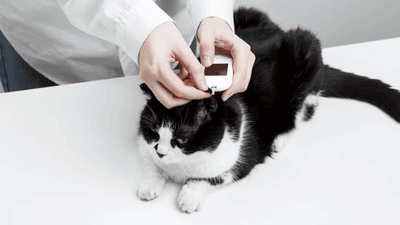
Diabetes is a chronic condition that affects both dogs and cats, just as it does humans. It occurs when the body cannot produce enough insulin or effectively use the insulin it produces, leading to high blood sugar levels. If left untreated, diabetes can cause severe health complications in pets, including organ damage and even death. However, with proper management, pets with diabetes can lead happy and healthy lives.
Diabetes mellitus is a metabolic disorder characterized by high blood sugar levels (hyperglycemia) due to insufficient insulin production or insulin resistance. Insulin is a hormone produced by the pancreas that helps regulate blood sugar levels and allows cells to use glucose for energy.

Certain breeds are more prone to diabetes, including:
Excess weight is a significant risk factor for diabetes, especially in cats. Obesity can lead to insulin resistance, making it harder for the body to regulate blood sugar levels.
Older pets are more likely to develop diabetes. Female dogs and male cats are also at higher risk.
Conditions such as pancreatitis (inflammation of the pancreas) can impair insulin production and lead to diabetes.
Long-term use of corticosteroids can increase the risk of diabetes in pets by causing insulin resistance.

If you notice any symptoms of diabetes, take your pet to the veterinarian for a thorough examination. The vet will assess your pet’s overall health and look for signs of diabetes.
A blood test will measure your pet’s blood glucose levels. Consistently high blood sugar levels are a key indicator of diabetes.
A urine test can detect the presence of glucose and ketones, which are byproducts of fat breakdown that accumulate in the blood when insulin is insufficient.
Regular exercise helps regulate blood sugar levels and maintain a healthy weight. However, avoid overexertion, as this can cause blood sugar levels to drop too low.
Your vet may recommend monitoring your pet’s blood sugar levels at home using a glucometer. This helps ensure that insulin dosages are effective and allows for timely adjustments.

DKA is a life-threatening condition that occurs when the body breaks down fat for energy, producing toxic ketones. Symptoms include vomiting, lethargy, and a sweet-smelling breath.
High blood sugar levels can lead to the formation of cataracts, causing vision loss or blindness.
Diabetes can damage the kidneys, leading to chronic kidney disease.
Nerve damage, particularly in the hind legs, can cause weakness or difficulty walking.
Obesity is a significant risk factor for diabetes, so ensure your pet maintains a healthy weight through a balanced diet and regular exercise.
Routine checkups allow your vet to detect early signs of diabetes and other health issues.
Limit treats and table scraps, which can contribute to weight gain and insulin resistance.
If your pet is predisposed to diabetes due to breed or age, consider regular blood sugar monitoring to catch the condition early.
Establish a consistent daily routine for feeding, exercise, and insulin administration to help manage your pet’s diabetes effectively.
Learn as much as you can about diabetes and how it affects your pet. This will help you make informed decisions and provide the best care.
Work closely with your veterinarian to develop a tailored management plan for your pet. Regular follow-ups are essential for monitoring progress and making adjustments as needed.
Managing diabetes can be challenging, but with patience and dedication, you can help your pet live a comfortable and happy life.
Many pet owners have successfully managed their pets’ diabetes. For example, one owner shared how their diabetic cat thrived after switching to a high-protein diet and receiving daily insulin injections.
Diabetes in dogs and cats is a manageable condition with the right care and attention. By recognizing the symptoms, seeking prompt veterinary care, and following a tailored management plan, you can help your pet live a healthy and fulfilling life. Regular monitoring, a balanced diet, and insulin therapy (if needed) are key components of diabetes management. Remember, your veterinarian is your best resource for guidance and support. With dedication and love, you can provide your diabetic pet with the care they need to thrive.